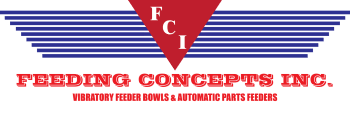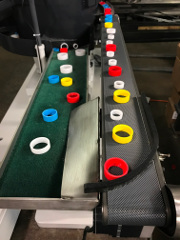Feeding Concepts Inc. was requested to present round aluminum parts end to end down an assembly line in a correct orientation. The parts were symmetrical, with internal differences that had to be presented leading or trailing in a correct orientation. With no real outer differences in the part a camera was used to see the inner hole leading and trailing. Feeding them to the robot with 100% orientation was a must for the customers application.
Feeding Concepts Inc. designed a vibratory feeder with a vision system to check for proper orientation of the parts leading and trailing. The camera detected whether the chamfer was leading or trailing on the inner edge of the part as it moved along the vibratory bowl tooling. Using a sensor trigger, the camera takes a photo at the correct moment as the part passes and detects a misoriented part. It then fires an air jet to blow the bad part out of the selector and back into bowl return pan.
Using a vision system in the bowl tooling Feeding Concepts Inc. saved the machine builder from sensing and flipping the part 180 degrees. Feeding Concepts was able to accomplish this in the vibratory feeder tooling with a high rate of feed, this saved any need for a mechanical flip and reduced the size and cost of the system.
This machine fed many parts, some were end to end with no differences and some were selected end to end with the vision system. This was done with a simple program change by the customer giving the end user the flexibility to change over to another part in minutes. The camera can simply run the correct program for the correct part to detect visual differences when part change over is needed. New parts can be added to the system in the future with little to no tooling changes.
For more information please visit our Vision System web page.



